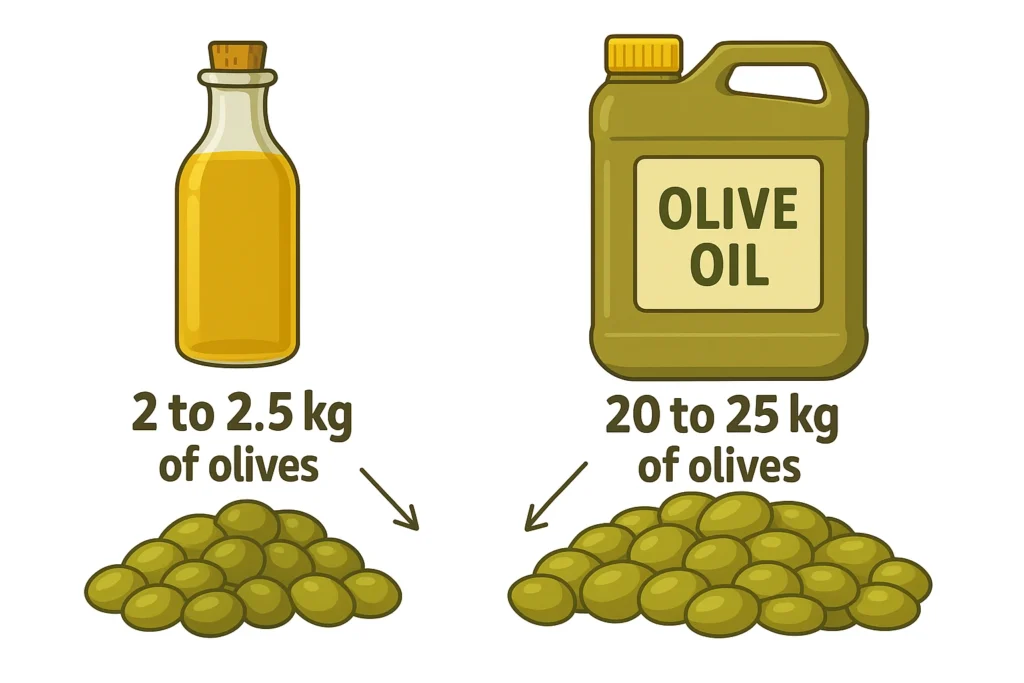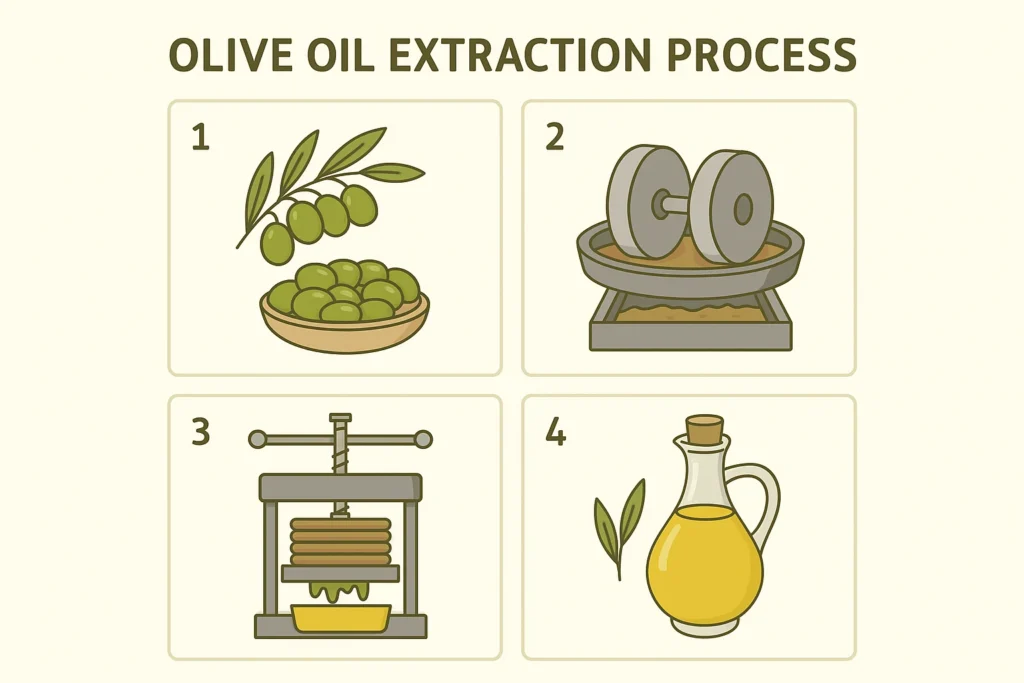How Many Olives to Make Olive Oil? Guide + Olive To Oil Yield Calculator

How Many Olives to Make Olive Oil
-
It takes between 4 and 5 kilograms (8.8 to 11 pounds) of olives to produce one liter of extra virgin olive oil — but this number can vary based on olive type, ripeness, and how the oil is extracted.
How Many Olives You Need to Make Olive Oil
To produce one liter of extra virgin olive oil, you typically need between 4 and 5 kilograms (8.8 to 11 pounds) of olives. This number can vary depending on the olive variety, ripeness, and extraction method used.
Most raw olives contain only 10% to 20% oil by weight. The rest is made up of water, pulp, skin, and the pit. That means a large portion of the fruit is left behind during pressing — and only a small fraction becomes oil.
Here’s what that looks like in practice:
- 500 ml of olive oil requires about 2 to 2.5 kg of olives
- A 5-liter container takes roughly 20 to 25 kg of olives
Understanding how many olives to make olive oil helps small-scale producers, gardeners, and home pressers plan their harvests and estimate their output more accurately.
Olive-to-Oil Yield Calculator
What Affects How Many Olives You’ll Need for Olive Oil?
Even if we use the general rule — 4 to 5 kg of olives per liter of oil — the actual number depends on a variety of conditions. To truly know how many olives to make olive oil, you have to look at a few key yield influencers:
1. Olive Variety (Cultivar)
Some olive varieties are bred specifically for oil production, while others are intended primarily for eating. The type of olive you’re working with has a huge impact on your oil yield.
Here are a few examples:
- Koroneiki (Greece): A high-oil-content variety, yielding up to 25% oil by weight. Often considered the gold standard for small-scale growers.
- Arbequina (Spain): Small, hardy, and excellent for home gardens. Produces soft, buttery oil with a high yield.
- Picual (Spain): Excellent yield and high in antioxidants, making it a great choice for long-lasting oil.
- Manzanilla (Spain): A classic table olive — flavorful, but not ideal for oil due to low yield.
If you're trying to get the most oil per kilogram, choosing a high-yield cultivar is essential.
2. Ripeness of the Olives
Oil content increases as olives mature. That means the timing of your harvest has a big effect on both yield and flavor.
- Green or underripe olives contain less oil (closer to 10%) but produce oils with a bold, grassy flavor and strong antioxidant levels.
- Ripe (black or purple) olives have a higher oil content (up to 20–25%), yielding more oil per kg but with a milder, fruitier flavor.
Some producers choose to blend olives harvested at different stages to balance yield and taste.
3. Time Between Harvest and Processing
Olives degrade quickly once harvested. The longer they sit before being processed, the more water they lose — and the more oxidation occurs. This leads to:
- Lower oil yield
- Poorer quality oil
- Higher free acidity (bad for EVOO status)
Best practice? Process olives within 24 hours of harvesting to preserve both yield and flavor.
4. Extraction Method Used
- Traditional pressing (stone mills or hand presses) typically produces less oil and may leave up to 15% of the potential yield in the olive paste.
- Modern centrifugal systems (like two- or three-phase decanters) extract oil more efficiently and cleanly.
In small home setups, you might lose a little yield for the sake of simplicity — but that tradeoff is usually worth it for personal use.
Choosing the Right Olive Varieties for Maximum Oil Yield
Olive Oil Yield by Variety and Ripeness
If you're looking to minimize how many olives you need to make olive oil, your best bet is to choose cultivars that are bred for oil extraction. These varieties not only offer more oil per kilogram but are often easier to grow and harvest.
Here are some of the most efficient oil producers:
- Koroneiki (Greece) – Small fruit, high oil: 20–25% yield
- Picual (Spain) – Excellent storage life, bold flavor
- Frantoio (Italy) – Fruity, high-quality oil, great for artisanal blends
- Arbequina (Spain) – Soft, nutty oil, great for small farms
These trees are ideal for growers who want to get the most oil with the fewest olives — a major consideration when calculating how many olives to make olive oil from your harvest.
The Health Value Behind Every Drop of Olive Oil
Beyond flavor and versatility, olive oil is valued for its powerful health benefits — especially when it's extra virgin and freshly pressed. It’s packed with bioactive compounds like polyphenols and antioxidants, which are known to support heart health and reduce inflammation.
In fact, a study published in the Journal of the American College of Cardiology found that higher olive oil intake was associated with a lower risk of cardiovascular disease. The research emphasized olive oil’s role as a heart-healthy fat when consumed regularly as part of a balanced diet.
So, when you're wondering how many olives to make olive oil, remember — you're not just producing a cooking staple. You're pressing out a health-supporting, antioxidant-rich superfood in liquid form.
Not sure how many olives you’ll need? Try the Olive-to-Oil Yield Calculator below to estimate based on your harvest."
Step-by-Step: How to Make Olive Oil from Fresh Olives?
So you’ve harvested your olives — what now? Making your own olive oil is a surprisingly hands-on, satisfying process. Knowing how many olives to make olive oil is just the first step. Now, it’s time to extract that golden liquid.
Step 1: Harvest
Pick olives when they’ve reached your ideal flavor profile — green for bold oils, black for mellow. Quality starts at the tree.
Step 2: Clean
Remove leaves, twigs, and dirt. A clean batch is crucial for a clean taste.
Step 3: Crush the Olives
Use a hammer mill, stone wheel, or mechanical grinder. This creates a thick, pulpy paste.
Step 4: Malaxation
Gently mix the paste for 30–45 minutes. This allows small oil droplets to merge into larger ones for easier extraction.
Step 5: Extract the Oil
Either press the paste manually or use a centrifuge. The cleaner and faster your system, the more oil you’ll get — and the fewer olives you’ll need to make olive oil.
Step 6: Filter and Store
Unfiltered oil can be rich and earthy, while filtered oil has a cleaner, longer shelf life. Store in dark bottles, away from light and heat.
Not sure how many olives you’ll need? Try the Olive-to-Oil Yield Calculator below to estimate based on your harvest."
Sustainable and Cost-Efficient Olive Oil Production
Reducing how many olives you need to make olive oil is also about being sustainable and smart with resources. Small producers and home growers have the unique ability to optimize for both quality and the environment.
Sustainability Best Practices:
- Compost leftover mash and pits for use as fertilizer or fuel
- Use rainwater and greywater systems for irrigation
- Share tools and equipment with neighboring growers
- Use solar-powered presses when possible
Cost Considerations:
- Upfront investment: ~$500–$1,000 for small-scale pressing equipment
- Per-liter cost: Often $3–6 for home production
- Store prices: $12–30 per liter for artisanal EVOO
By managing your inputs wisely, you’ll lower how many olives it takes to make olive oil at home — and gain a more sustainable product.
Not sure how many olives you’ll need? Try the Olive-to-Oil Yield Calculator below to estimate based on your harvest."
Frequently Asked Questions
How many olives do you need for olive oil?
👉 Between 4 and 5 kilograms (8.8 to 11 lbs) of olives are required to produce one liter of extra virgin olive oil.
How much olive oil can one olive tree produce?
👉 A mature tree, depending on conditions, can yield 20–40 liters of oil per year, which means it must produce 80–200 kg of olives, depending on the yield rate.
Is it healthy to eat 20 olives a day?
👉 While olives are rich in antioxidants and healthy fats, they’re also high in sodium. It's best to stick to 16–24 olives per day for balanced intake.
If you're still curious about how many olives to make olive oil, this FAQ section sums up the essentials with clarity.
Final Thoughts
Whether you're curious about how olives turn into oil or planning to press your own batch, knowing how many olives to make olive oil is just the beginning. With the right knowledge, equipment, and olive varieties, producing your own oil can be deeply satisfying — and deliciously rewarding.


